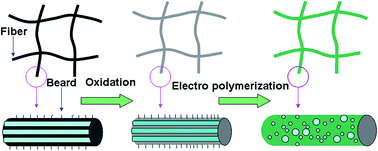Asymmetric hybrid capacitors based on novel bearded carbon fiber cloth–pinhole polyaniline electrodes with excellent energy density†
Abstract
It is well known that electronic conductivity and kinetics of ion diffusion determine the large current discharge capacity of electrode materials. Hence, we envisioned construction of an integrated smart structure for which fast ion and electron transfer were guaranteed. This paper presents a novel bearded carbon fiber cloth (CFC) decorated with pinhole polyaniline (PANI) formed by electro-polymerization to achieve excellent electrochemical properties. The pinhole nanostructure of redox-active PANI exposed a high electrolytic-attainable surface area and the bearded CFC would serve as an excellent 3D conductive skeleton, which would supply a direct channel for electron transport. As the current density increased from 1.3 to 16.5 A g−1, the PANI/CFC still maintained a higher specific capacitance; the specific capacitance decreased from 808 F g−1 to 749 F g−1, only ∼7% loss of capacitance, which implies that the PANI/CFC electrodes have excellent rate capability. The optimal composite electrodes achieved a high area-normalized capacitance of 3.3 F cm−2. The asymmetric hybrid capacitors based on optimal composite electrodes were tested in a cell voltage region of 0–1.6 V and exhibited high energy densities with values of 36.35 Wh kg−1 and power densities of 422.15 W kg−1. The results showed that the combination of porous PANI with bearded CFC significantly increased the capacitance of the electrode and enhanced its electrochemical performance.


 Please wait while we load your content...
Please wait while we load your content...